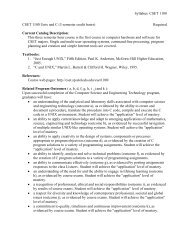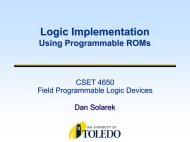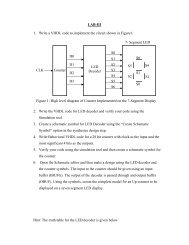Programmable Logic and Application Specific Integrated Circuits
Programmable Logic and Application Specific Integrated Circuits
Programmable Logic and Application Specific Integrated Circuits
Create successful ePaper yourself
Turn your PDF publications into a flip-book with our unique Google optimized e-Paper software.
is expected to go up as improved processing technology allows smaller geometry transistors which<br />
are more susceptible to transient upset. However, these problems are less likely to occur in<br />
SRAM based FPGAs than SRAM memory. FPGA storage cells typically have much higher load<br />
capacitance making them more immune to transient upset, <strong>and</strong> they typically have lower impedance<br />
power connections. Also, packaging can affect soft-errors since chips in plastic packages have<br />
nearly ten times lower upset rates than ceramic packaged parts. EPROM <strong>and</strong> fuse-based nonvolatile<br />
FPGA technologies are sensitive to the calibration of the programmer. High field return<br />
rates are frequently based on failure to meet the manufacturers programming specifications or<br />
failure to perform adequate post-programming testing. EPROM based technologies are also<br />
sensitive to UV light; they can be erased in only a week of direct sunlight exposure or three years<br />
of fluorescent light exposure. Thus, proper h<strong>and</strong>ling <strong>and</strong> the use of opaque labels on UV-erasable<br />
parts is essential. One-time programmable versions of EPROM based FPGAs packaged in nonwindowed<br />
packages present no particular reliability concerns in this regard.<br />
b) Design <strong>and</strong> Test Issues<br />
When an FPGA is used in a system, the overhead related to chip programmability must be<br />
factored into the design. With SRAM programmable FPGAs, some non-volatile storage will be<br />
required for power-on initialization. In microprocessor-based systems where the FPGA is not<br />
required for the processor to boot, programming information can be stored in the processors ROM<br />
memory. In this situation the processor can program the FPGA chip as part of its power-on<br />
initialization sequence <strong>and</strong> the on-board programming overhead becomes negligible.<br />
Low pin-count serial PROMs are available which are specifically designed to store<br />
configuration bits; <strong>and</strong> most SRAM FPGAs are capable of initializing themselves from PROM<br />
without requiring external control circuitry. With the Xilinx family, multiple FPGAs can be<br />
chained together <strong>and</strong> initialized from a single PROM. However, the extra cost <strong>and</strong> board space for<br />
the PROM must be factored into the design. Finally, the use of in-circuit programmable EEPROM<br />
technology or combined EPROM <strong>and</strong> SRAM technology devices present unique system design<br />
opportunities. A system may power-on into a default configuration which is automatically loaded<br />
from EPROM into SRAM, then the SRAM programming can be modified during system operation<br />
to change the FPGA functionality.<br />
An additional programming overhead must be considered in the form of the added pins per<br />
chip. Special programming <strong>and</strong> mode control pins are needed, which makes the chip more<br />
expensive <strong>and</strong> consumes board area. In some devices, user I/O signals share pins with the<br />
programming signals which significantly reduces this programming overhead.<br />
Finally, the choice of FPGA programming technology affects testability in several ways.<br />
The use of one-time programmable parts adds additional system test requirements. It is generally<br />
not sufficient to rely on device programmer tests. Partially programmed fuses, anti-fuses, or<br />
floating gates may read back correctly on the programmer but cause the chip to fail at operating<br />
speed or temperature. On the positive side, SRAM based FPGAs add several unique testing<br />
opportunities. Special test configurations can be downloaded in the chips to test chip-to-chip<br />
36
















